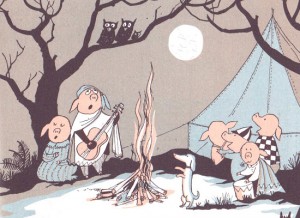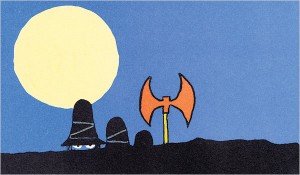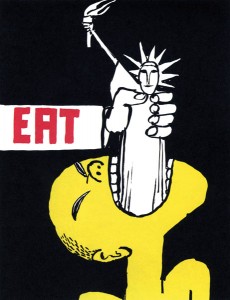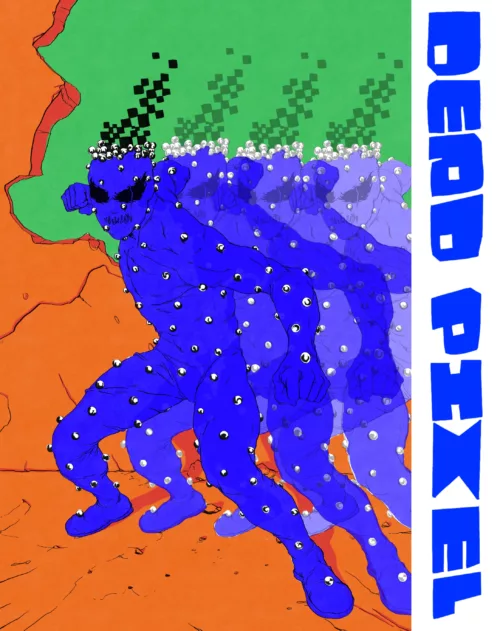—>Dashiell’s movie review of the new documentary about Tomi Ungerer makes us want to see the film soon!—the Artblog editors—————->
Far Out Isn’t Far Enough: The Tomi Ungerer Story” is a new documentary paying tribute to the eponymous illustrator – a visionary and highly controversial artist most renowned for his children’s books, but also famous for his anti-war posters, and his pornographic illustrations. Ungerer, now in his 80s, is the central figure of the film, narrating his own life story. The artist is wild, insightful, and often very funny, a thrilling persona to watch as he spouts aphorisms in a thick accent and sucks down hand rolled cigarettes. Throughout the film, interviews with Ungerer are interspersed with his varied illustrations brought to life through animation, adding texture and dynamism to what might otherwise be a static display of his oeuvre.

Growing up in Nazi-occupied Alsace
Ungerer was raised in Alsace, and grew up during World War 2. He lived under Nazi occupation and then under the scorn of the rest of France following the war, when Alsatians were abhorred as collaborators. Ungerer was traumatized by the violence, and the fear instilled in him during that time has been a major force behind his work to this day. The film lingers a bit too long on these memories, but thankfully manages not to get too bogged down.

In 1956, Ungerer moved to New York with almost no money and a portfolio of drawings. A relentless self-marketer, he found work in New York almost immediately with a children’s book publisher. His books became famous for their unusual themes and dark subjects. Ungerer made child-eating ogres, a trio of thieves, and a snake the subjects of some of his early work. Ungerer believed deeply that exposing children to these frightening characters and worlds was essential for their development and that the molly-coddling of books like “Dick and Jane” did more harm than good. Although out of the norm, Ungerer’s books won numerous awards and were favorably reviewed in publications like The New York Times, indicators of significant success at the time.

Dark children’s stories and hard-edged antiwar posters
Ungerer is a voracious artist, and his children’s books did not sate him. His firsthand experience with the horrors of war and oppression made him particularly sensitive to the atrocities of the Vietnam War. When that war escalated, Ungerer felt an insatiable yen to demonstrate his abhorrence of it with a series of anti-war posters. The posters are starkly drawn, with bold colors, crude figures, and often grotesque imagery underpinned with a clear political message – the US was a brutal aggressor. When released, they caused a significant stir, quickly becoming anti-war emblems.

Impact of his sexually-explicit drawings on his career
Just as Ungerer was inspired by the war and Civil Rights Movement, so too was he inspired by the sexual revolution and free love movement in the 60s. The artist began to draw a series of hyper-sexual drawings, depicting women in bondage gear and hooked up to elaborately designed Sadomasochistic machinery. Ungerer made a series of sculptures around similar themes as well, drawing in part from a massive collection of mutilated Barbie Dolls.

Eventually, Ungerer’s controversial drawings led to his downfall. In an era of conservative reactionism, it was anathema that a children’s book author could have such an openly deviant side. When Ungerer refused to recant, he was blacklisted. No newspapers would review his children’s books and school libraries refused to carry them. Ungerer went into a self-imposed exile, moving to Canada and then to Ireland. Although he continued to work on other projects, he would not publish another children’s book for 40 years.
Accolades at last
Ultimately, “Far Out Isn’t Far Enough” is a story of an artist who refused to dilute his artistic convictions and, through this perseverance, won back the praise and accolades that had been unfairly stripped from him. In 1990, Ungerer was awarded the Legion d’Honneur by the French government. In short order, numerous awards and accolades rolled in as Ungerer was rediscovered, his children’s books republished, and he began to write and illustrate again.

Although the dominant voice in the film is Ungerer’s, others weigh in as well. A host of authors and critics speak to Ungerer’s importance and influence, including the late great Maurice Sendak, who credits Ungerer for making him a braver writer and illustrator and insists that “no one was as original as Tomi.” The film is deeply compelling, in large part because Ungerer himself gets so much screen time. Writer/Director Brad Bernstein wisely remains absent from the film, letting Ungerer and his artwork speak largely for itself. The result is an absorbing homage to this singular artistic voice.
More information about the film, which is in select theaters now, can be found here. Tomi Ungerer’s website, which includes a biography and bibliography, can be found here.






